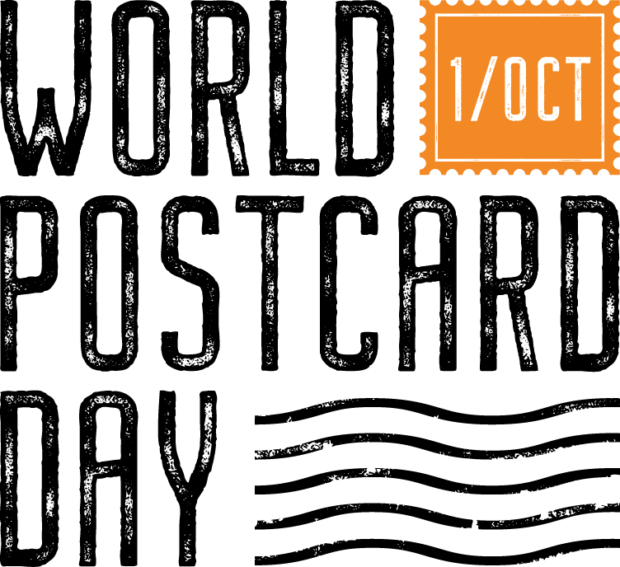
Oct. 1 is World Postcard Day (WPD). The day is an annual celebration of the hobby of sending and collecting postcards. It’s more than just about the postcard itself—it’s the community and the stories that are the real treasures that we celebrate.
It’s celebrated on Oct. 1 to commemorate the day the postcard—an idea from Dr. Emanuel Herrmann, a professor of economics from Vienna—came into being. On Oct. 1, 1869, the Austrian Post released what is now known as the Correspondenz-Karte—a light-brown 8.5- by 12- centimeter rectangular card with space for the address on the front, and room for a short message on the back. The postcard featured an imprinted two-Kreuzer stamp on the top right corner—the amount was half the cost of a regular letter. Herrman later became known as the Father of Postcards.
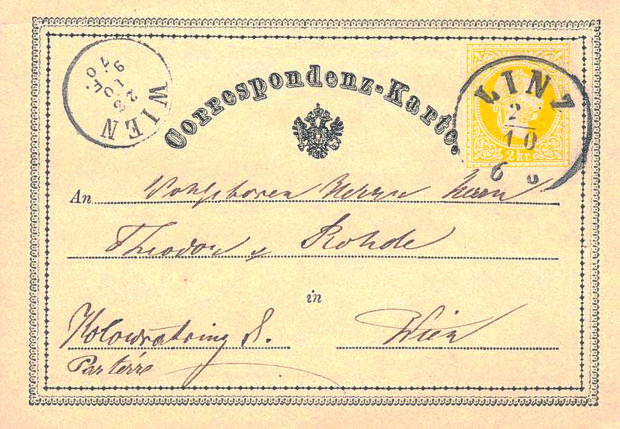
Artworks as postcards
Ma. Luisa “Lui” Ronquillo-Hikong is a creative designer and postcrosser who sells her artworks as postcards and other postcrossing materials. She is one of the go-to persons for postcards. Her business Doodle ni Maria offers a wide choice of designs, from Filipiniana to zodiac signs.
Ronquillo-Hikong doesn’t just design postcards, she’s a postcrosser herself. “I did not plan on selling the postcards, they were just meant for swaps. I was only interested in sending to others since that was my joy.”
She went on postcrossing.com so she could send her cards internationally as well. “I have regularly used the platform since 2019 but stopped during the pandemic. In the brief time I swapped internationally, they would often remark that my cards were uniquely Filipino, something that helps them learn more about our culture,” she said.
Her customers continue to be her main inspiration. “Sometimes, I am not in the mood to create but whenever I hear their recommendations, I feel revived and inspired to work. One time, I made three designs in a day. That was for World Postcard Day. So many people were looking for the design and I was moved to fulfill their wants.”
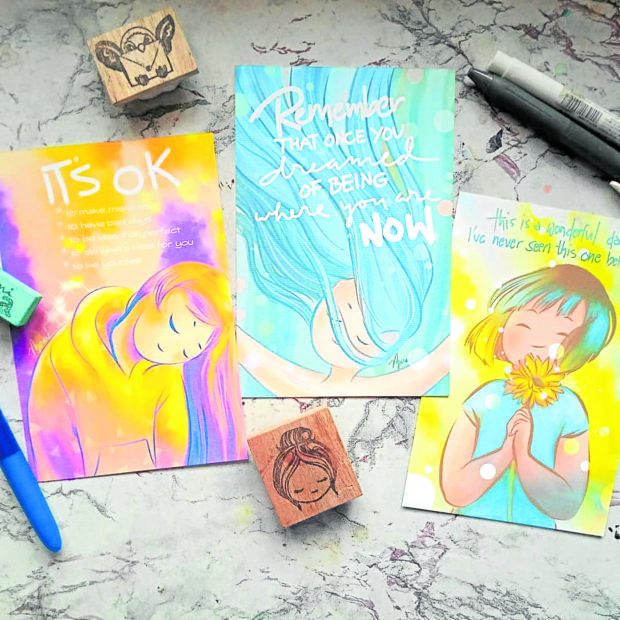
Spreading joy
Ronquillo-Hikong makes sure her postcards can fit anyone’s budget. “I want everyone [to be able] to afford and enjoy my cards while spreading joy to others as well. Others purchase just for their collection, while some purchase for swaps. Sometimes they make special requests for me to sign their cards and I happily oblige.”
She releases seasonal designs too for Valentine’s, summer and Christmas. She said, “Sometimes it’s hard to know what will sell. There are designs that I did with ease which resulted in major success. And then there were the ones that took a lot of effort [but weren’t as successful].”
She hopes her postcards help spark a new tradition. She believes that despite the digital age, there are still perks to sending a physical greeting to friends or family. “I am looking for a physical store or a place where I can consign my products. I can see it being beneficial especially for seasonal postcards.”
For Ronquillo-Hikong, WPD is “the celebration of postcards, a dying hobby in the Philippines.” She added, “It’s a good celebration as it advocates for postcards and snail mail. It’s a celebration of giving, it’s about the messages delivered.”
With this year’s WPD postcard designs, she wants to “convey happiness and the passion for writing postcards, something I am returning to. I want to convey the uniqueness of the practice. Nowadays we are used to online shopping, receiving something that brings joy. If people are accustomed to receiving products via couriers then why not letters through the mail system?”
She shared, “The first design, Magazine, looks like a magazine cover. On the front, you can see a few details about the event and a barcode that you can scan for a surprise. The second design is called Mail. The concept shows different people receiving postcards. It shows how postcards are sent all across the world and reminds us how postcards can transcend language. The third one is called Poster which features Filipino elements including the PhlPost truck.”
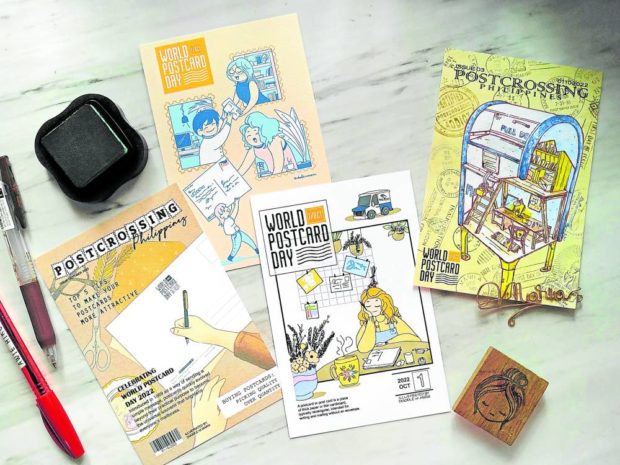
Therapeutic
She calls writing on postcards a therapeutic experience. “It’s a hobby that bears fruit and brings joy. We send out cards with the intention of making someone happy.”
Sibelle Estrada is a postcrosser and a regular customer of Doodle ni Maria. “As a Filipino postcrosser, we usually lack designs [to choose from]. Artists like Doodle ni Maria promote postcrossing, encourage people to try it out at low costs while at the same time promote Philippine culture.”
Estrada likes how Doodle ni Maria’s postcards, like her COVID-19 series, incorporate emotions and life experiences. “The designs explored her anxiety and how much she missed prepandemic moments with her family.”
But why do people like postcrossing? Estrada has answers based on her observations of the local postcrossing community. “Postcrossing is something people enjoy as it helps them to know other people randomly. Sending postcards makes events more memorable with a physical reminder. The designs are very cute. Even though we do not write long messages on the back, the design shows the message we want to send them. Postcards show a person how much they mean to the sender. It’s more meaningful compared to the click of a button.” Another draw are the stamps. “The wonderful stamps. We learn a lot both from postcards and stamps.”
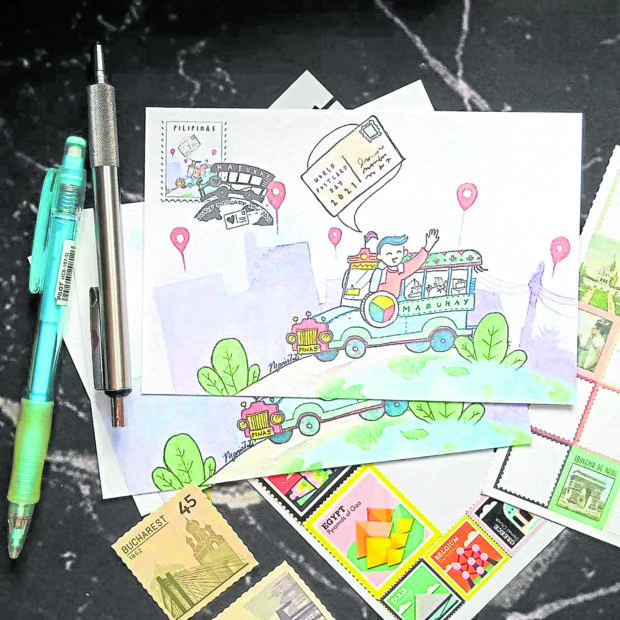
Lessons
Writing and sending postcards can teach you lessons as well. You get to be more open while spreading good vibes to others. It’s a reminder of the importance of history. It teaches you patience—it is snail mail, after all. You become more appreciative of others. They also help you unleash your creative side.
Postcrossing is for everyone, no matter what age and background.
Aine Magalang, a third year Communications student from Marinduque, has been a postcrosser for five years. It’s a way of honoring her father. “I do postcrossing in memory of my father so this hobby will always be close to my heart.”
For her, the joy is about all the people she gets to connect with. “We have these long-distance friends that we meet along the way. I love how the hobby connects people around the globe. Also, I am really happy whenever I get to share something about the island province where I live.”
She talked about the hobby’s comforting effects during the pandemic. “Postcrossing really kept me sane during the lockdown. We only had limited countries we could send to back then but thankfully, we still had the chance to send mail despite the lockdown. I couldn’t imagine what my quarantine life would have looked like without postcards. It really is my breather after a stressful day or week. Preparing each card makes me feel relaxed. It inspired me to keep going.”
Getting started
Want to get into postcrossing?
Estrada says that you should start by sending cards to your family and friends. Just surprise them with a sweet postcard and try to experiment when writing on the cards you send them.
When you feel that you have a connection with the hobby, join a group. Estrada recommends people to join the PostCrossing Philippines Facebook group. It’s a friendly community and a great place to learn more about postcards and get tips on how to start.
“It’s a very good and safe community for those who want to enter postcrossing. We watch our own. We have games, raffles and engaging activities. It’s a community that’s filled with positivity. Everybody is very understanding.”
The group is also a good way to discover local postcard sellers.
You might also want to try swapping with international postcrossers. It’s a great way to create bonds with others worldwide and also a chance to share your culture and stories.
Estrada said, “It’s a happy thought that on this day, millions of people around the globe are going to send postcards and make somebody happy. We spread happiness and cheer one postcard at a time.”
—CONTRIBUTED













































